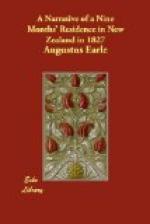The slight intercourse of the discoverers with the natives had so calamitous a termination, and the exaggerated accounts it was then a kind of fashion to give of savages, stigmatised the New Zealanders with such a character for treachery and cruelty, that their island was not visited again for upwards of a century, when the immortal Cook drew aside the veil of error and obscurity from this unexplored land, and rescued the character of its inhabitants from the ignominy which its original discoverers, the Dutch, had thrown upon them. This immense tract of land was imagined by Tasman to form but one island, and he most unaptly gave it the name of New Zealand, from its great resemblance (as was stated) to his own country.[2]
In 1770 Cook discovered a strait of easy access and safe navigation, cutting the island nearly in half, thus making two islands of what had before been imagined but one. This strait bears his name, and is often traversed by vessels from New South Wales returning home by way of Cape Horn.
In 1827 His Majesty’s ship Warsprite passed through this strait in company with the Volage, twenty-eight guns, being the first English line of battleship which had ever made the attempt. A few years since, Captain Stewart, commanding a colonial vessel out of Port Jackson, discovered another strait, which cut off the extreme southern point, making it a separate island that bears his name, and now almost every year our sealers and whalers are making additional and useful discoveries along its coasts.
These islands lie between lat. 34 deg. and 48 deg.S. and long. 166 deg. and 180 deg.E. The opening of the land to which we were now opposite, and which was our destined port, the accurate eye of Cook had observed, but did not attempt the entrance; and it is only about ten years since, when the two store ships, the Dromedary and Coromandel, loaded with spars on the coast, that a small vessel attending on those ships first crossed the bar; but although they took soundings and laid down buoys, the commanders of the large vessels were afraid of attempting the entrance, which proved their good sense, for their great draught of water would have rendered the undertaking more hazardous than the risk was worth. Yet during my residence in this country two large vessels crossed the bar, and recrossed it heavily laden, without the slightest accident—one the Harmony, of London, 400 tons burden; the other the Elizabeth, of Sydney, of nearly equal tonnage—but in proof that it is not always safe, a few months after this, two schooners of extremely light draught were lost, though they were both commanded by men who perfectly well knew the channels through the bar. It was a singular circumstance that both vessels had been built in New Zealand; one, the Herald, a small and beautiful craft, built by and belonging to the Church missionaries, the crew of which escaped, but the disastrous circumstances attending the wreck of the other, called the Enterprise, I shall relate in their proper place.




